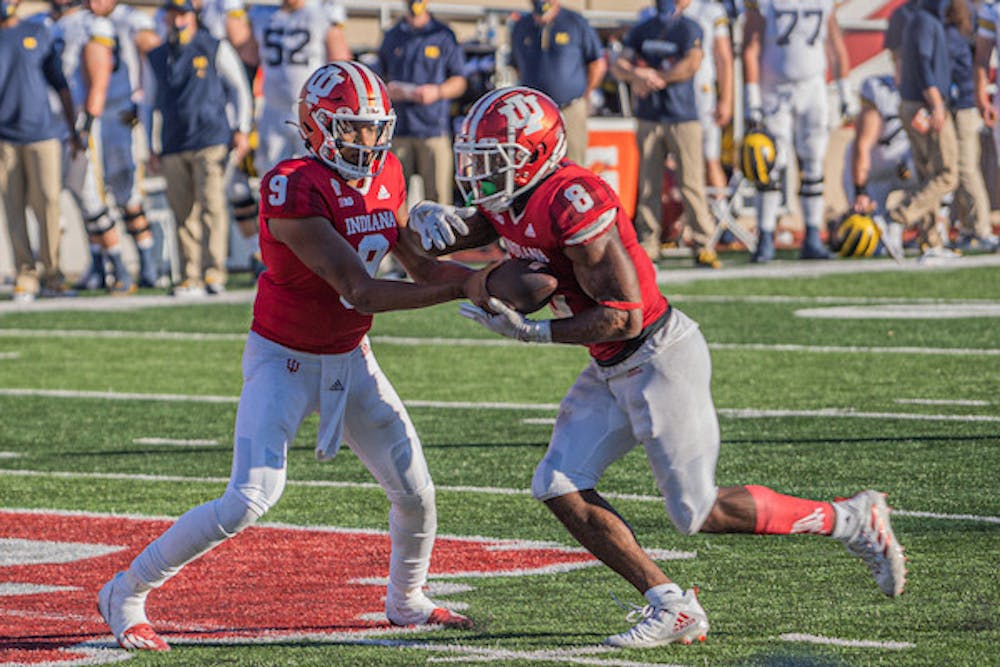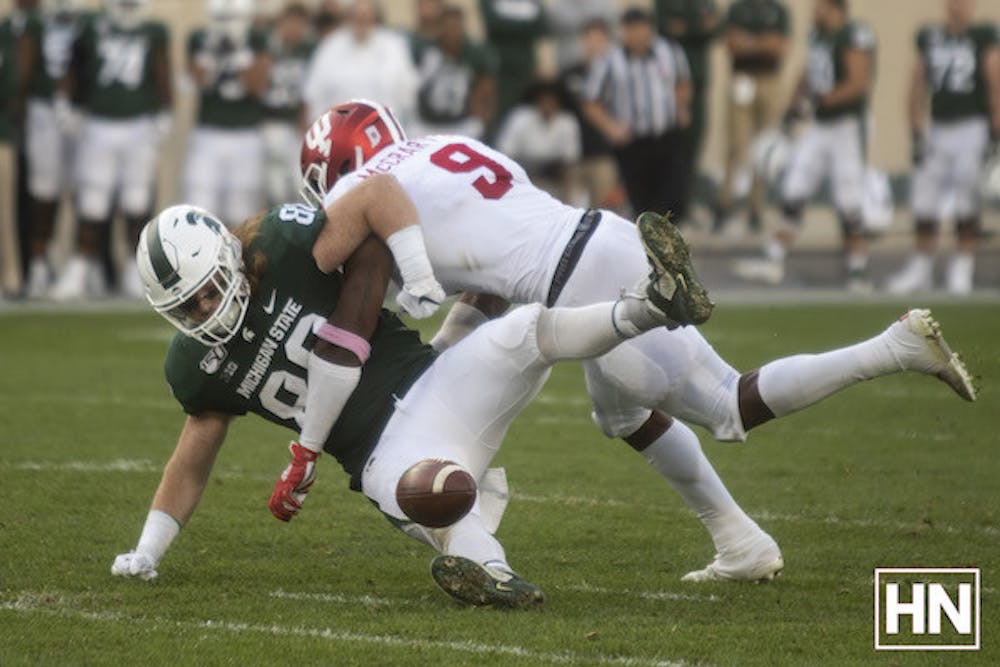A sense of belief was created around Indiana football in 2020, and it will return 18 of its 22 starters in 2021.

Each player was granted another year of eligibility from the NCAA in an effort to not deter players from sitting due to COVID-19 concerns. However, seniors Whop Philyor, Harry Crider, Jerome Johnson and Jovan Swann chose not to exercise their extra year at Indiana and enter the NFL Draft. Juniors Stevie Scott and Jamar Johnson also elected to enter the NFL Draft.
While the Hoosiers will be without a few household names in 2021, the vast majority of the team that beat Penn State, Michigan, Michigan State and Wisconsin in the same season for the first time in program history will be back in Bloomington next season. Wide receiver Ty Fryfogle, safety Marcelino McCray-Ball, defensive back Raheem Layne, defensive end Mike Ziemba and offensive lineman Mackenzie Nworah recently announced their return to Indiana for the 2021 season.
Let’s break down the impact of these decisions from the past week.
Hoosiers lose arguably two best linemen
A major key to winning games in the Big Ten is being able to control the line of scrimmage, both offensively and defensively. The Hoosiers struggled to build a consistent rushing attack for most of the 2020 season, and the inability to pressure Ole Miss quarterback Matt Corral was part of Indiana’s downfall in the Outback Bowl.
With the loss of center Harry Crider and defensive tackle Jerome Johnson, the offensive and defensive lines immediately stick out as areas of needed development entering 2021. Crider was one of five team captains for Indiana, and with injuries to Marcelino McCray-Ball and Michael Penix Jr., his leadership became even more important as the season progressed. Redshirt sophomore Charlie O’Connor is a candidate to take over for Crider at center.
Johnson went from someone with just one FBS offer in high school to a first-team All-Big Ten selection by the media and second-team by the coaches. Johnson became the first Indiana defensive lineman since 1993 to earn first-team honors. Joining Johnson’s departure from Indiana is fellow defensive tackle Jovan Swann, who was a graduate transfer from Stanford.
Jerome Johnson is a first team All-Big Ten defensive tackle.
But the Bassfield, MS native has become much more than just a quarterback terrorizer, as Indiana gets set for the @outbackbowl.@epstein_griffin has the story. #iufb pic.twitter.com/2w9eNB0jVH
— The Hoosier Network (@TheHoosierNet) January 2, 2021
After Indiana’s 26-20 loss to Ole Miss in the Outback Bowl, Tom Allen did not waste much time on the recruiting trail. Allen was able to gain the commitment of transfer Ryder Anderson, who was a defensive end on the Ole Miss team that gave up its lowest point total of the season to Indiana. Anderson recorded a sack in this game, and announced on Jan. 8 that he will use his final year of eligibility at Indiana.
“Ryder has proven to be an excellent football player in the SEC,” Allen said in a statement on Jan. 12. “He is long, athletic and plays extremely hard. Ryder brings a level of leadership to our defensive line room and his addition makes us a better football team.”
Departure of multiple Maxwell Award Watch List candidates
Before the season, Indiana set a program record for most players named to the Maxwell Award Watch List, which is given to the best player in college football. Michael Penix Jr., Whop Philyor and Stevie Scott earned spots on the list, but Indiana will be without two of the three in 2021.
Stevie Scott announced on Jan. 15 that he will forgo his senior season and enter the draft. Due to running backs’ careers being generally shorter than most other positions, it makes sense that Scott would want to start cashing NFL checks as soon as possible.

While the Hoosiers had more success this year through the air than on the ground, Scott was a reliable red-zone weapon. Scott’s yard total regressed each year as a Hoosier, but his size and strength could make him an attractive pick in the later rounds of the draft. In three seasons at Indiana, Scott totaled 2,543 rushing yards, 30 touchdowns and showed the ability to be effective in the passing game, hauling in 53 catches for 383 yards and two touchdowns.
Scott’s exit should not be too much of a negative for the Indiana offense, though, as the Hoosiers maintain two young running backs who have shown flashes in backup roles. Sampson James was a highly-touted recruit who originally committed to Ohio State, but has yet to really shine as a Hoosier.
James has averaged 3.3 yards per carry in 113 attempts in two seasons, and his similar build to Scott make it realistic for him to carry a lead-back role for Indiana.
James won’t be handed the starting job too easily, though. Tim Baldwin Jr. had a breakout performance against Maryland, rushing 22 times for 141 yards. With James and Baldwin in the backfield, the development of the offensive line is more of a concern than losing Scott.
Nick Sheridan talked about blocking "angles" as part of what IU would look to improve in the run game. Not sure if this is what he means, but this outside run play works. IU's o-line gets moving laterally, walls off, and creates a cutback lane for Tim Baldwin. #iufb pic.twitter.com/J6qMFTDxp4
— Jon Blau (@Jon_Blau) November 30, 2020
Perhaps the two most impactful offensive decisions for Indiana came with opposite results. Big Ten Receiver of the Year Ty Fryfogle will be back with Indiana for the 2021 season. Fryfogle seemed to develop strong chemistry with Michael Penix Jr. before his injury, which makes this decision to return even more intriguing with the hopes of a healthy Penix next year.
Philyor later announced he will enter the NFL Draft, leaving Indiana without its most reliable slot receiver and fan favorite. In Philyor’s final game as a Hoosier, he set an Indiana record for most receptions in a game with 18.
Miles Marshall will take over a good deal of Philyor’s targets after a strong sophomore season behind two of the conference's best receivers. Indiana also gained the commitment of Florida State transfer DJ Matthews, who was the No. 51-ranked player in the class of 2017.
Matthews has a similar skillset to Philyor, possessing great speed agility and standing at 5-feet-11 and 160 pounds. Matthews caught 36 passes for 355 yards and three touchdowns for Florida State in 2019.
A big loss, but possibly a bigger addition to the secondary
Jamar Johnson led Indiana with four interceptions and was second with 43 tackles, but has entered his name into the 2021 NFL Draft. The Hoosiers will miss his eye for turnovers, but also possess a lot of depth in the secondary. Before Johnson’s departure, Indiana would have had six players in the secondary who had previously earned an All-Big Ten honor.
A career-high 10 tackles and one interception later and @IndianaFootball's Jamar Johnson has earned co-Defensive Player of the Week honors!@IUHoosiers // #LEO pic.twitter.com/KHPEyrxPFY
— Indiana On BTN (@IndianaOnBTN) October 26, 2020
Before the season, Indiana took a huge hit when Marcelino McCray-Ball tore his ACL. McCray-Ball was projected to be the team’s starting husky, a safety-linebacker hybrid position that carries high importance in Kane Wommack’s defense.
But on Jan. 5, McCray-Ball announced he will return to Indiana for his fifth season of eligibility. He completed a monster season as a freshman in 2016, totaling 75 tackles, eight pass deflections, two interceptions and a fumble recovery, but was injured for most of his sophomore season.
While McCray-Ball has a history of injuries, he should immediately slot back into the husky position for Indiana and provide a strong sense of leadership. Alongside Tiawan Mullen, Devon Matthews and Reese Taylor, Indiana should once again have one of the Big Ten’s top secondaries.






